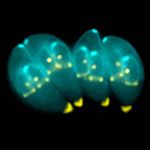| Question
|
Answer
|
Article
|
| What is the transmission and life cycle of Eimeria species?
|
- Direct transmission
- Faecal-oral route
|
Link to Answer Article
|
| What is the transmission and life cycle of Isospora species?
|
- Usually direct transmission by the faecal-oral route
- Some species use facultative intermediate hosts forming tissue cysts
- Transmission is then by the faecal-oral or route or via ingestion of the intermediate host
|
Link to Answer Article
|
| How long is the prepatent period of poultry Eimeria species?
|
- 1 week
- Sporulation takes 2-3 days
|
Link to Answer Article
|
| Name the malabsorptive Eimeria species
|
- E. maxima
- E. acervulina
- E. mitis
- E. praecox
|
Link to Answer Article
|
| Name the haemorrhagic Eimeria species
|
- E. necatrix
- E. brunetti
- E. tenella
|
Link to Answer Article
|
| Which area of the gastrointestinal tract does E. acervulina, E. maxima, E. tenella and E. necatrix affect and what kind of lesions are produced?
|
- E. acervulina affects the proximal gut forming white ladder lesions
- E. maxima affects the mid-gut producing a pink exudate
- E. tenella affects the ceaca forming a core of dark, haemorrhagic blood
- E. necatrix affects the mid-gut forming salt and pepper leions
|
Link to Answer Article
|
| What are the two main Eimeria species which affect cattle and what is the prepatent period?
|
- E. zuernii
- E. bovis
- 2-3 week prepatent period
|
Link to Answer Article
|
| What are the two significant Eimeria species which affect sheep and what is the prepatent period?
|
- E. ovinoidalis
- E. crandalis
- 2 week prepatent period
|
Link to Answer Article
|
| What is the most significant species of Isospora which affects pigs and what the prepatent period?
|
- I. suis
- 1 week prepatent period
|
Link to Answer Article
|
| Which parts of the gastrointestinal tract do the Eimeria species which affects rabbits inhabit?
|
- 2 inhabit the caecum
- 1 inhabits the bile duct epithelium (E. steidae)
|
Link to Answer Article
|
